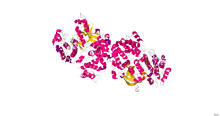G protein-coupled receptor kinases
| G protein-coupled receptor kinase | |||||||||
|---|---|---|---|---|---|---|---|---|---|

|
|||||||||
| Identifiers | |||||||||
| EC number | 2.7.11.16 | ||||||||
| Databases | |||||||||
| IntEnz | IntEnz view | ||||||||
| BRENDA | BRENDA entry | ||||||||
| ExPASy | NiceZyme view | ||||||||
| KEGG | KEGG entry | ||||||||
| MetaCyc | metabolic pathway | ||||||||
| PRIAM | profile | ||||||||
| PDB structures | RCSB PDB PDBe PDBsum | ||||||||
| Gene Ontology | AmiGO / QuickGO | ||||||||
|
|||||||||
| Search | |
|---|---|
| PMC | articles |
| PubMed | articles |
| NCBI | proteins |
G protein-coupled receptor kinases (GRKs, GPCRKs) are a family of protein kinases that regulate the activity of G protein-coupled receptors (GPCRs) by phosphorylating their intracellular domains after their associated G proteins have been released and activated.
The phosphorylated serine and threonine residues act as binding sites for arrestin proteins that prevent the reassociation of the G proteins with their receptors, thereby preventing reactivation of the signaling pathway.
GRKs regulate also cellular responses independent of their kinase activity. In particular, G protein-coupled receptor kinase 2 interacts with a diverse repertoire of non-GPCR substrates.
GRK1 is involved with Rhodopsin phosphorlylation and deactivation. Defects in GRK1 result in Oguchi disease 2.
...
Wikipedia
